A letter from George Eastman to the treasurer of the Rochester Patriotic and Community Fund hangs in the lobby of the United Way of Greater Rochester on College Avenue.
Typewritten on stately-looking Eastman Kodak stationery and dated June 29, 1918, the letter refers to checks that Eastman enclosed for $500,000 and $75,000.
Eastman is the founder of the Community Fund, the forerunner to the United Way, and his letter is a reminder of his philanthropic legacy and strong sense of obligation to the community, says United Way CEO Peter Carpino.
Eastman pressed some of the most important city leaders of the day to share that same sense of duty: Edward Bausch, Hiram Edgerton, James Gleason, Carl Lomb, and Hiram Sibley, to name a few.
United Way has been at the epicenter of charitable giving in Rochester for decades, infusing the region with $20 million to $30 million annually.
But the organization has had to make a seismic shift, dramatically changing how it appeals to donors and how it stewards the funding it provides to roughly 60 organizations that support about 80 human service programs.
Another 600 organizations benefit from donor-designated gifts through the United Way, Carpino says.
In some ways, the organization's reinvention couldn't have happened at a worse time. The economic hailstorm that drove through Rochester over the last three decades hit hardest many of the people who depend on the services supported by United Way.
And by many measures, the needs of the community have grown more urgent, adding to United Way's fund-raising pressures.
Carpino, who retires in June, says that his job is to ask people to invest in Rochester — not the easiest sale to make. Reaching younger donors who view charitable giving differently than previous generations is particularly challenging, he says.
This year, United Way's funds will help fill 300,000 requests for food, shelter, and clothing. And 2,400 new parents will receive in-home parenting training, while 6,200 children will participate in afterschool, summer school, and mentoring programs.
And United Way will play a leading role in Governor Andrew Cuomo's new Rochester Anti-Poverty Task Force.
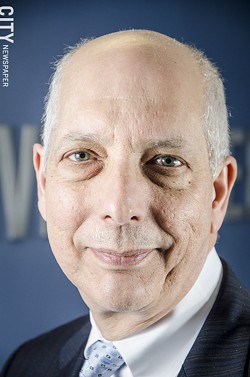
- PHOTO BY MARK CHAMBERLIN
- United Way CEO Peter Carpino.
In a recent interview, Carpino spoke about the challenges that United Way faces, and how the organization has changed since he joined in the late 1970's.
He says that the value of donating to United Way is that it has vetted agencies for programs that tackle the root causes of some of Rochester's most complex and embedded problems, such as violence and low graduation rates.
The following is an edited version of that discussion.
CITY: People may wonder if the United Way is still relevant. What would Rochester be like if United Way no longer existed?
Carpino: When you think of United Way as the old Community Chest or even the United Way of the 1970's through the early '90's, the idea was a workplace-based campaign that raised money. And then we distributed it to worthwhile organizations that were meeting local needs. The fact is that proposition lost its value 10 years ago.
The question I'm often asked is, "Why United Way? Why don't I just give to the agencies of my choice?" We made the determination about nine years ago that the way that we add value to the community is not by raising and distributing money.
It's, how do we take a comprehensive look at this community's most pressing social issues? And, how do we identify the root causes of those issues?
And then, how do we apply a limited charitable dollar to programs that are addressing those root causes in a very strategic and targeted way?
That's where our value comes through.
If you were to look at this organization 20 years ago, we would say something like, "Give to us and you'll help to support these organizations that are doing good work."
But one of the most significant changes we've made since then is what we're saying to donors today: "Entrust your money with us. We'll invest those dollars not only in programs that do good work, but most importantly, in programs that have been proven to work."
Close to 65 percent of all of the dollars we are investing back into the community are going to evidence-based programs. That is huge.
So when someone asks about the value of United Way today, do you as a donor want the assurance that you're investing in an organization that knows this community and what the issues are?
An organization that knows, based on research, what programs can help address those issues?
Isn't some of what drove this change based on how our economy changed? At one time, you could look to a few large corporations with thousands of employees for most of your donations. Now you have to talk to many smaller businesses.
Yes. Anyone who has been in this community for a long while knows how much it has changed. And we've had to completely rethink our traditional workplace-based fund-raising model. It used to be what marketers would describe as business-to-business.
If you were the CEO of a company and I had a relationship with you, we would run a campaign with you in your company for the thousands of employees you had. And my relationship was with you as the CEO of the company — not so much with the individual donors within that company.
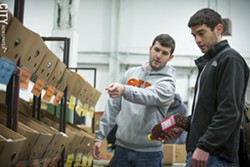
- Photo courtesy the United Way of Greater Rochester
- Foodlink volunteers sort donations. Foodlink is supported by the United Way Community Fund.
We had to shift from a business model to going directly to consumers. The workplace is still very important to us. It is an entrance for us, a point of access to those employees who we have to be able to communicate with.
But we now have to communicate directly with donors on a year-round basis, and go to small business owners and approach them as individuals even during non-campaign periods.
That's a much harder proposition. Is it sustainable?
Rochester has one of the strongest small-to-mid-size business markets on the Eastern Seaboard. And there's no question about it, small and mid-size businesses are recognized as the economic driver of this community.
Part of what I hope we're beginning to do is to create the expectation that small and mid-size businesses are also in a position to become the new philanthropic drivers of this community. This is unusual. I mean, think about how empowering that can be for Rochester.
What about younger people who are less familiar with United Way? Do millennials, for instance, think differently about charitable giving than boomers?
Let me explain that this way: We went from the old, large manufacturing-based economy with Kodak, Xerox, and Bausch + Lomb to what is now a service and high-tech economy. That was one enormous economic change.
But a second change that we experienced as a community that is less apparent is what I'll call increased consolidation, particularly in the financial services. And in other businesses, as well.
This means that every time there has been an out-of-town ownership replacing what was previously a locally-owned company, it shifts the center of gravity. You now have folks who are not as committed to the local community like some of the other older leaders once were.
And there's a third issue that we're dealing with, which is increased competition, and that speaks especially to younger donors.
This younger work force has a different set of expectations from employers, and quite frankly, no longer has the kind of loyalty to employers that a young professional might have had when they were hired at a company here 30 years ago.
How does that impact us? If you started at a company 30 years ago and the company CEO said that it's part of our culture to give back to the community and the way we do that is by giving to United Way, people basically agreed.
The younger employee doesn't feel that they have to do that. So one of the issues we're dealing with is that we have very low penetration right now in the 18- to 44-year-old market. And 60 percent of our current donors look like me. They're boomers.
This is why we're moving directly to the consumer. We have to meet donors where they are and where they are may not be at the workplace. This is why we introduced "ROC the Day," our 24-hour charitable giving blitz. It's a way for people to give back, and they're doing it on their terms.
They don't need the workplace vehicle. We established another web-based platform called "Gathering to Give" to make it easier for small and mid-size businesses to give. These are some of the ways we're trying to respond.
We have a lot of young professionals advising us in very meaningful ways. And what they're telling is that it's not about the money. How can they get engaged in the community with their time, talents, and energy? And then their money may follow, but it's going to be on their terms.
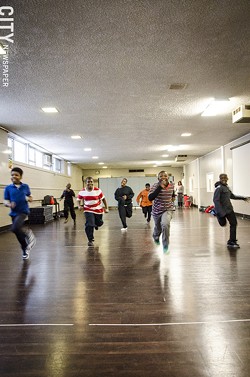
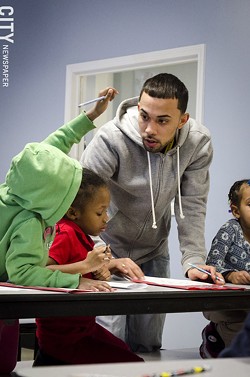
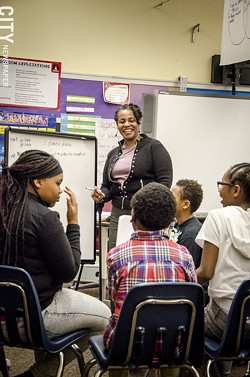
|
In the age of the Internet, people can give to causes all over the world. Does it help to appeal for a donation that will go to a local organization?
One thing we need to help people understand is that it doesn't need to be an "either-or" decision. It can be a "both-and" decision. You want to support environmental causes and elephant preserves? Fabulous.
And we'd also ask that you look around this community at the serious issues we're dealing with here. We cannot afford to lose sight of what it means to advance the common good. It's wonderful that we have generous people who want to give back in ways that are large and small, that choose something that they're passionate about.
But if everybody goes off in their own directions, who speaks for the most disenfranchised in our community? Who advances the common good? Who even thinks about our community from a strategic standpoint?
Some people say they don't give to the United Way because they can't control where their money goes.
It's not true. Better than 25 percent of every dollar we raise is earmarked by donors to individual charities of their choice. We focus on health and human services, and we've broadened it to include arts and culture around their education programs for youth.
Religious institutions and colleges and universities are not included in that. But we're making investments to between 70 and 80 programs delivered by 60 organizations. We have another 600 organizations that benefit in ways large and small from United Way though donor-designated gifts.
So it is a misperception that they're giving up control.
Does United Way have many large individual donors?
We have the second-largest endowment of any United Way in the country, second only to Seattle. The market value on that endowment is about $110 million. And that represents the gifts of long-time United Way supporters who have chosen to leave a legacy for future generations.
When you think of major donors, we have about 235 people in this community who give an annual gift of $10,000 or more.
You have an unusual vantage point of Rochester. What are the two or three most pressing challenges for this community?
If you look at the big issues, of course, you're looking at poverty, particularly childhood poverty. You're looking at children not succeeding in school. You're looking at people having to turn to others for help getting their basic needs met. And then you're looking at the challenges of an aging demographic.
Six years ago, we decided to focus on four areas: early childhood, school-age youth, basic needs, and the fourth was in the area of older adults and their caregivers. Before we developed our plan, we went out into the community and surveyed about 1,200 people. They talked about community violence and academic failure being their major concerns.

- Photo courtesy the United Way of Greater Rochester
- An afterschool program at Volunteers of America, supported by the United Way Community Fund.
Now just take the issue of violence. When you talk about the root causes of violence, the research will tell you that violence later in life is most often caused by child abuse and neglect. So when we set up our early childhood strategies, we looked at programs that reduce child abuse and neglect.
For example, one of those programs that is evidence-based and backed by decades of research is the Nurse-Family Partnership in Monroe County.
Home visitation programs like that one and another one that we started with the county called Building Health Children, and a third one called Parents as Teachers focus on improving parenting skills.
Research shows that if we can help people become better parents, there's a marked decrease in abuse and neglect, as well as a whole host of other things like reduced infant mortality and reduced visits to the hospital.
By the reduction in abuse and neglect, not only are we helping to make sure that these children are entering school healthy and ready to learn, research shows that we have reduced violence later in their lives.
Programs like the ones you mentioned require a long-term investment to see the benefits. How do you keep the focus on the programs and avoid jumping to the newest shiny proposal?
Our funding process is open to the entire service provider community as long as they understand what our objectives are and they're willing to partner with us to deliver on those goals.
If you're running an agency and you say, "I have an afterschool program or summer enrichment program," you're going to have to deliver that program according to a design that all of our afterschool providers use.
In a sense we have become much more prescriptive: "Here are our expectations; do you think you can meet them?" Then we visit with the agencies quarterly.
Now if they are not delivering on their objectives and we can't get that resolved, will there be a shift in funding? Yes, there will be.
How many proposals do you get and how do you say no?
They're in the hundreds. We work on three-year funding cycles and we put out a call for proposals. It's a very open process.
And the guidelines that we've set up make it much easier to say no. We are very clear, particularly with limited charitable dollars. We must make sure that we're doing the right things. We can't do everything.
Some community leaders say that we're saturated with nonprofits and that we are not always successful at getting them to work together and pool their resources.
Do we have too many agencies and is there duplication of effort? This has been a major focus of ours over the last decade. How can we help agencies to consider consolidation, affiliation, and even merger to help them to do business differently?
We have had some success with that. Can we force them to merge? No. Can we be a resource? Absolutely.
You're not a banker though some people might think you play a similar role. What does it take to do your job?
I don't go around telling people I'm the CEO of United Way. I'm a salesman. I'm not selling you a widget. I'm selling you a vision for a better community.
